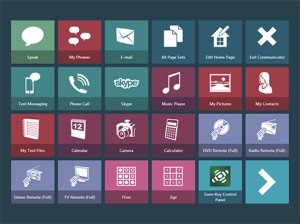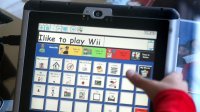Students With Limited Verbal Capabilities Can Thrive in Inclusive Classrooms
With the right support, students who cannot rely on natural speech to communicate can do well in integrated classrooms.
Your content has been saved!
Go to My Saved Content.My first exposure to a student who used augmentative and alternative communication (AAC) was when I taught in a self-contained disability-specific special education classroom. The student, Ringo, had a device like a small laptop that he used to type words and sentences, which were spoken aloud by the device. When Ringo received the device, I didn’t get much training other than a few consultations with the speech and language pathologist and a pat on the back for good luck.
After 13 years in the classroom, I realize now what I wish I knew then: Students who cannot rely on speech to be understood don’t have to be educated in segregated classrooms. And for educators who have students who require communication supports, training or preparation doesn’t have to be complex.
An estimated 1.3 percent of Americans cannot reliably meet their daily communication needs using natural speech. With schools increasingly educating students with disabilities in inclusive classrooms, educators will likely come across people who need or use AAC in their classroom as part of a co-teaching model or with assistance from a paraprofessional.
Here are four ways educators can prepare for students who need AAC.
1. Get Familiar With AAC
According to the nonprofit Communication First, AAC is any method of communication used by people with speech or communication disabilities to supplement or take the place of verbal speech. This can include no-tech aids (like pointing, gesturing, or signing), low-tech options (such as a paper board with words, letters, and symbols on it), or high-tech solutions (such as a computer with text-to-speech software).
Some students will use AAC all the time, others only in certain situations. And while some people think that the use of AAC may limit students, using a communication system only empowers people who would not otherwise express themselves reliably.
2. Watch AAC in Action
There are examples in TV and movies of people using AAC that the disability community has universally panned, but fortunately there are also some authentic portrayals. One of the best ways to learn more about people with disabilities is to hear directly from them or interact with media heavily influenced by their voice. Here are a few movies and short films to get you started.
Listen (2021): A short film made by and with nonspeaking autistic people.
The Reason I Jump (2021): A feature-length film based on the biography of Naoki Higashida, who is autistic and nonspeaking.
Loop (2020): A short film by Pixar and Disney highlights Renee, a nonspeaking autistic girl who makes friends with Marcus, a speaking boy, when the two go canoeing together at camp.
Thasya (2012): This powerful short film is a profile of Thasya Lumingkewas, an 8-year-old autistic girl.
Carr Brackett (2008): In this short film, Carr, a young man with Down syndrome, uses his AAC to support his communication needs in a general education classroom.
3. Use the Communication Bill of Rights as a Guide
First published in 2016, the Communication Bill of Rights from the National Joint Committee for the Communication Needs of Persons with Severe Disabilities states that “all people with a disability of any extent or severity have a basic right to affect, through communication, the conditions of their existence.” The list of rights, which consists of 15 points for educators to consider, focuses on the dignity and respect of the person with communication support needs.

The first point, “to interact socially, maintain social closeness, and build relationships,” is an important one for teachers to implement. Teachers can be intentional about including AAC users in groups where there are students accepting of differences to help facilitate friendships.
If you include planned interactions in lessons where the AAC user can “make comments and share opinions,” you can align with the bill of rights’ goals. For example, during a class review of a reading passage, give the AAC user time to craft their answer to a question and call on them at a predetermined time. When you give them time to process, they can be prepared with their answer. Wait time benefits all students, so this is a good idea in any classroom.
Another critical thing to consider is a student’s right to “refuse or reject undesired objects, actions, events, or choices.” Like students who use natural speech, if an AAC user refuses to participate in a class activity, there’s typically a reason. Educators can make an effort to ask the student directly about how they can be more comfortable participating in the activity.
4. Practice Strategies for Promoting Communication for All Students
Supporting students who use AAC doesn’t have to be complicated:
Students who cannot rely primarily on speech to communicate are often the first to be placed in segregated special education classrooms. But what I learned from Ringo is that supporting communication can happen in the general education setting—it just takes a willingness to listen.
